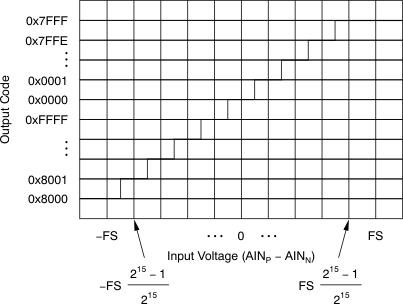ZHCSEE1F October 2010 – September 2019 ADS1118
PRODUCTION DATA.
- 1 特性
- 2 应用
- 3 说明
- 4 修订历史记录
- 5 Device Comparison Table
- 6 Pin Configuration and Functions
- 7 Specifications
- 8 Parameter Measurement Information
- 9 Detailed Description
- 10Application and Implementation
- 11Power Supply Recommendations
- 12Layout
- 13器件和文档支持
- 14机械、封装和可订购信息
封装选项
机械数据 (封装 | 引脚)
散热焊盘机械数据 (封装 | 引脚)
- RUG|10
订购信息
9.5.6 Data Format
The ADS1118 provides 16 bits of data in binary twos complement format. A positive full-scale input produces an output code of 7FFFh and a negative full-scale input produces an output code of 8000h. The output clips at these codes for signals that exceed full-scale. Table 5 summarizes the ideal output codes for different input signals. Figure 39 shows code transitions versus input voltage.
Table 5. Input Signal versus Ideal Output Code
| INPUT SIGNAL, VIN
(AINP – AINN) |
IDEAL OUTPUT CODE(1) |
|---|---|
| ≥ +FS (215 – 1)/215 | 7FFFh |
| +FS/215 | 0001h |
| 0 | 0 |
| –FS/215 | FFFFh |
| ≤ –FS | 8000h |
(1) Excludes the effects of noise, INL, offset, and gain errors.
 Figure 39. ADS1118 Code Transition Diagram
Figure 39. ADS1118 Code Transition Diagram